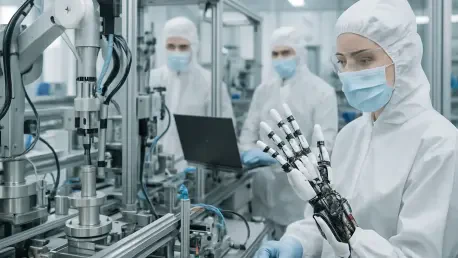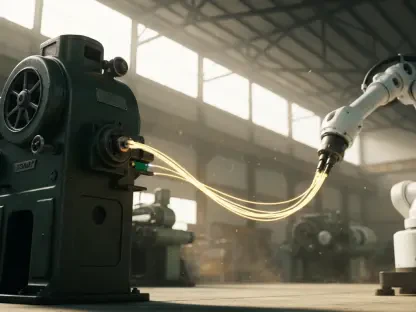I’m thrilled to sit down with Oscar Vail, a renowned technology expert whose groundbreaking work in emerging fields like quantum computing, robotics, and open-source projects has positioned him at the cutting edge of innovation. Today, we’re diving into the transformative role of artificial intelligence in medical manufacturing, an industry where precision and efficiency are paramount. Our conversation explores how AI is revolutionizing everything from equipment maintenance to quality control, optimizing supply chains, automating processes, and turning raw data into strategic insights. Oscar’s expertise offers a unique perspective on how these advancements are shaping the future of healthcare production.
How is AI reshaping the overall landscape of medical manufacturing, and what specific areas have seen the most significant changes?
AI is fundamentally changing medical manufacturing by driving precision and efficiency to levels we’ve never seen before. It’s like giving the industry a superpower—enhancing everything from production speed to product reliability. The biggest impacts so far are in predictive maintenance, where AI prevents costly equipment breakdowns, and quality control, where it ensures products meet incredibly strict standards. Areas like supply chain management are also being transformed, with AI forecasting demand and preventing shortages or overstock. It’s a game-changer across the board, especially for companies producing medical devices or supplies where there’s zero room for error.
Can you walk us through how AI helps predict equipment failures before they happen in medical manufacturing?
Absolutely. AI in predictive maintenance is all about staying one step ahead. It uses sensors embedded in machinery to collect real-time data on things like temperature, vibration, and wear. Then, algorithms analyze this data to spot patterns or anomalies that signal a potential failure. Think of it as a doctor monitoring a patient’s vital signs—except here, the patient is a production machine. By catching issues early, manufacturers can schedule repairs during downtime rather than dealing with unexpected breakdowns that halt production. It’s a proactive approach that saves both time and money.
In terms of quality control, how does AI improve the inspection process for medical products compared to traditional methods?
AI-powered vision systems are a huge leap forward in quality control. These systems use cameras and machine learning to inspect products at lightning speed, catching defects that even the sharpest human eye might miss—like microscopic cracks or inconsistencies in medical devices. Unlike humans, AI doesn’t get fatigued, so it maintains a consistent level of accuracy no matter how long the production run. Plus, it can log every detail automatically, which is crucial for meeting FDA or ISO standards and ensuring traceability. It’s not just about catching errors; it’s about building trust in the product.
How does AI contribute to optimizing supply chains in medical manufacturing, especially when it comes to managing inventory and predicting demand?
AI acts like a crystal ball for supply chain management. It analyzes a ton of data—historical production numbers, market trends, even external factors like weather or geopolitical events—to predict demand for raw materials or finished products. This means manufacturers can keep just the right amount of inventory, avoiding shortages that delay production or overstock that ties up capital. For example, during a sudden spike in demand for medical supplies, AI can help adjust orders in real time. It’s all about creating a lean, responsive system that keeps everything running smoothly.
Let’s talk about automation. How is AI-driven automation enhancing routine tasks in medical manufacturing, such as assembly or sterilization?
AI-driven automation is taking repetitive, labor-intensive tasks and making them faster and more precise. In assembly, for instance, robotic systems with machine learning can adapt to slight variations in components—say, a batch of parts that’s slightly off-spec—and still put them together correctly. In sterilization, AI ensures the process meets exact standards every time, reducing the risk of contamination. The beauty is that these systems learn and improve over time, cutting down on errors and boosting throughput. It allows manufacturers to scale up production while keeping quality rock-solid, though human oversight remains key for safety.
How does AI turn the massive amounts of data generated in medical manufacturing into actionable insights for better decision-making?
Medical manufacturing produces a flood of data—think machine performance stats, production rates, quality checks, you name it. AI steps in as a super-smart analyst, sifting through this data to find patterns and inefficiencies that humans might overlook. For example, it can pinpoint a bottleneck in the production line or predict when a machine will need maintenance before it slows things down. These insights help managers allocate resources better, cut costs, and make strategic decisions that keep them competitive. It’s like having a dashboard that not only shows you what’s happening but also tells you what to do about it.
Looking ahead, what is your forecast for the future of AI in medical manufacturing over the next decade?
I’m incredibly optimistic about where AI is headed in this space. Over the next ten years, I expect we’ll see even deeper integration—think smarter predictive analytics that can anticipate issues with near-perfect accuracy, and automation that’s so advanced it can handle highly complex tasks with minimal human input. Quality control will likely evolve with AI systems that not only detect defects but also suggest real-time fixes on the production line. We’ll also see AI play a bigger role in personalizing medical devices at scale, tailoring production to individual patient needs. The potential for efficiency and innovation is limitless, but it’ll be crucial to balance this with ethical considerations and robust cybersecurity to protect sensitive data. It’s an exciting time to be in this field.









